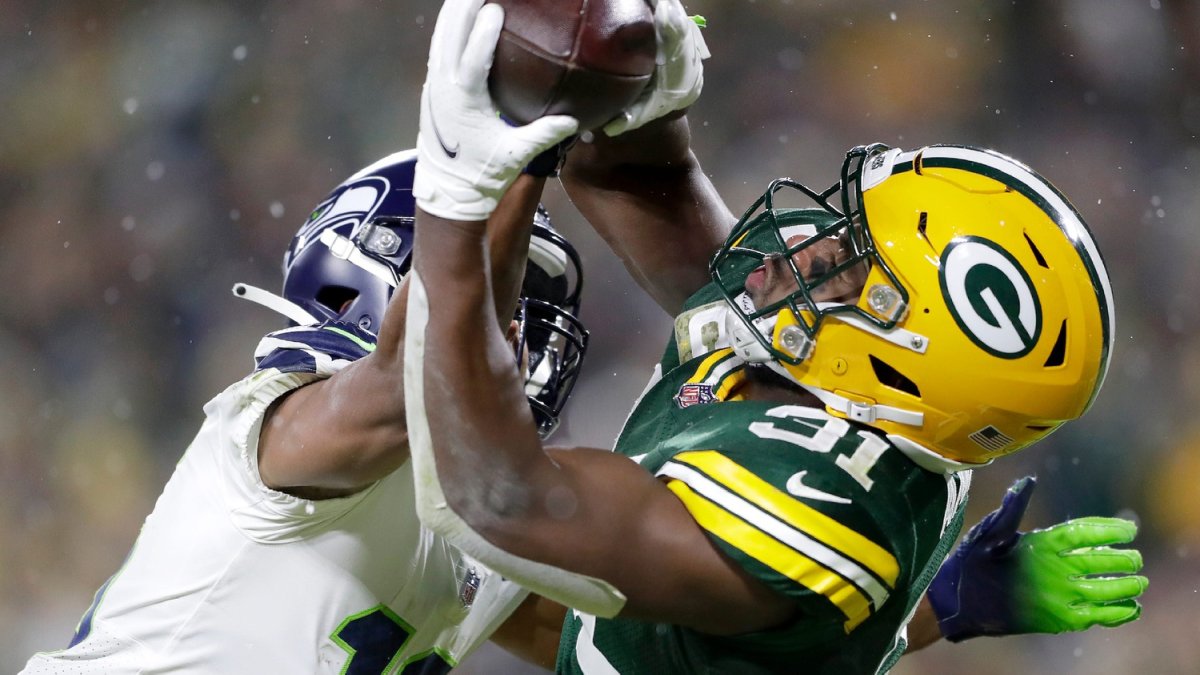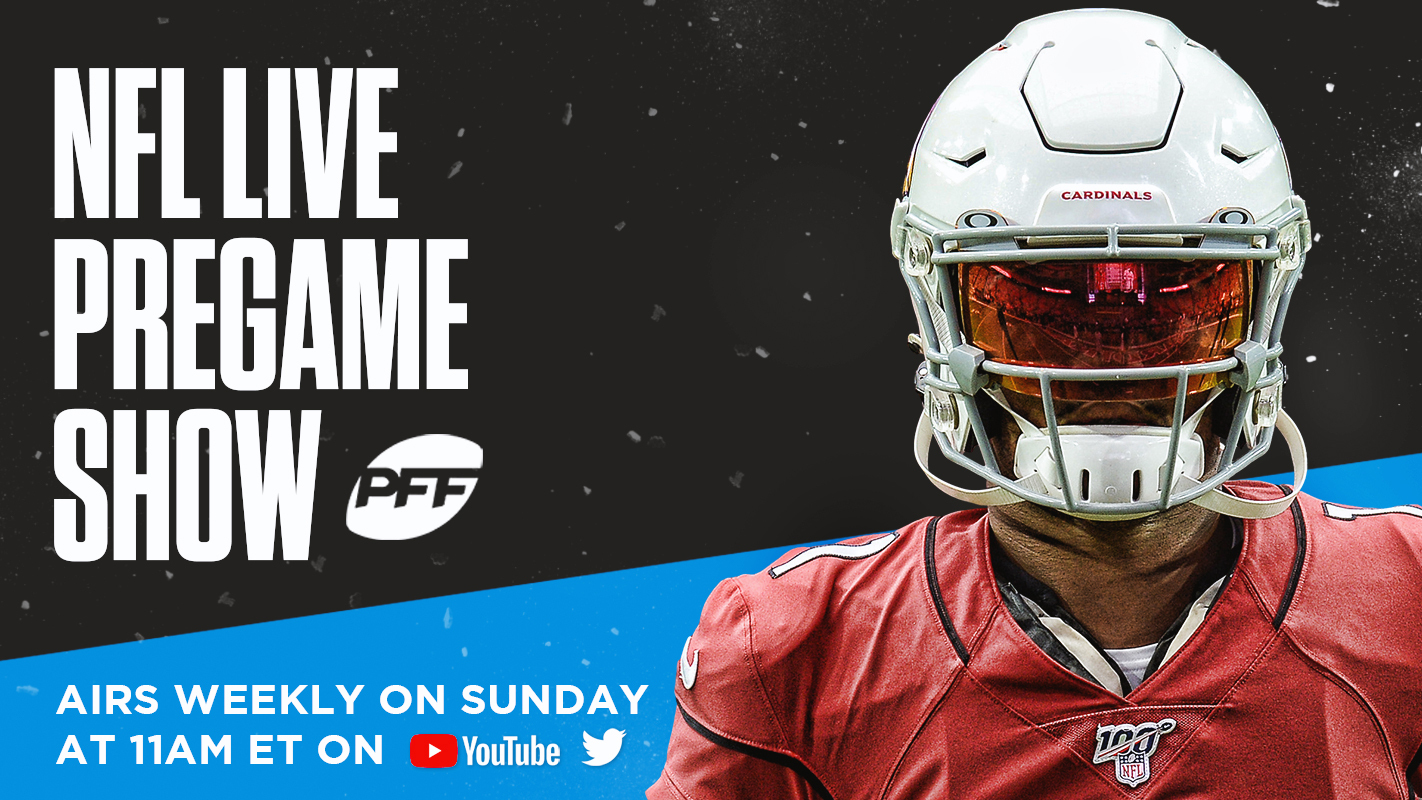In a sport that can feel wholly trapped in small sample size theater, crossing the midseason point of the NFL season is a significant mark in identifying which early-season narratives are borne from data while taking stock of the unexpected storylines that have cropped up.
Each week, we will examine the data and film to find the best and worst of the NFL action on both sides of the ball. This week we will focus on two particular positive trends on defense in Week 10.
Click here for more PFF tools:
Rankings & Projections | WR/CB Matchup Chart | NFL & NCAA Betting Dashboards | NFL Player Props tool | NFL & NCAA Power Rankings
Like: Green Bay’s Air-Tight Coverage
With the season feeling as though it was slipping away from the Seattle Seahawks, Russell Wilson pressed to accelerate his rehab process for his injured hand. The thought process was right out of a football movie — the missing leader swoops in to inject energy and hope for a spiraling team.
Like any good sports movie, his reward was all of the positive energy being stamped out under the falling snowflakes in Green Bay, Wisconsin. The game was in the hands of Wilson over 40 times on Sunday, and one snap after another nobody was open.
Packers Defense | Week 10
| Metric | Figure (Rank) |
| Coverage Grade | 90.5 (1st) |
| EPA/Passing Play | -0.431 (4th) |
| Passer Rating Allowed | 41.7 (2nd) |
| Forced Incompletions | 6 (T-1st) |
Green Bay has made a swift transition in identity from Mike Pettine to Joe Barry, with much more emphasis on using the defense’s size up front, playing with true linebackers on the second level and trusting the deep safeties to make their nine teammates in front of them right when they’re wrong.
The best of Barry’s tenure so far has been a better implementation of split safety coverages — playing Cover 2 on one end and Cover 4 on the other. The Quarter-Quarter-Half look (Cover 6 to others) allows for something that Cover 3 doesn’t and structurally never could.
Packers Coverage Defense | 2021
| Zone Coverage Grade | 90.4 (1st) |
| Yards Allowed Per Coverage Snap | 2.79 (1st) |
In single-high safety defenses, coverage defenders can pass off routes as they distribute down the field because so many players are on the second level. But it has to be down from a “top-down” perspective, meaning the underneath defenders actually have to play deeper than certain routes — otherwise the spacing of the coverage will be warped to the point of uselessness. There’s a designated “no cover zone” where routes won’t be matched by defenders.
Two high safeties give underneath defenders vertical relief, and this eliminates the need to play with a no-cover zone.
A lot of the route combinations made to stretch out those zone areas in Cover 3 aren’t as good against Cover 6, because defenders can sit hard on underneath routes as they break.

On the top half of this clip, the Seahawks stacked their receivers and flared the back, a great idea against Cover 3 because it can manipulate the distribution of coverage defenders or force a defense to play deeper and softer.
This is the “halves” side of the coverage concept, and the corner and linebacker execute an “in-out” exchange to take the first WR releasing his way. From there, those players can attach to routes aggressively with the help of a safety over the top. The middle linebacker is taking the back all the way through to the flats as well, so there’s no added stress on the coverage.
On the bottom of the screen, the “quarter-quarter” side, the offense is running a high-low concept that beats Cover 3 as well, because there’s airspace to work into along the sidelines. In Cover 4, the safety and CB can take the corner route, and the slot defender is sitting on the underneath release.

How would an offense want to attack this? By running a deep post between the safeties, especially out of 3-by-1 when it’s easier to manufacture space. What Joe Barry has borrowed from Vic Fangio and Brandon Staley is playing halves coverage to the trips side and quarters to the single WR side, allowing the quarters safety in the seam to hunt for deep routes coming across the field. The corner-post route widens and eliminates the Cover 2 safety, but the Quarters-side safety sees it coming and meets the receiver where the ball is going.

As we progress, it’s clear to see the multiplicity of just one coverage concept, because a defense can just as easily flip the coverage against trips to play Cover 2 on the single WR side and Quarters to trips. A defense would do this to get a double team on the side of a dominant receiver, or if it trusts the trips-side corner to stand up in single coverage. Lucky for Green Bay, they have those corners, and now more can be invested in taking away a vertical threat like D.K. Metcalf.

Factored together, you take all of the oxygen away from an offense, and if there's a pass-rush presence, a defense can shut out a future Hall of Fame QB in his return to action.
Like: New Orleans’ Four-Down, Two-High Run Fits
Tennessee’s run game is missing its engine, and it can be excused for not putting up back-breaking numbers without the presence of its titan-sized RB Derrick Henry.
That alone is an incomplete representation of the domination we saw from New Orleans’ defense between the tackles.
New Orleans has been one of the best overall defenses year-over-year since defensive coordinator Dennis Allen returned to the staff, and it’s due in large part to his ability to find the schematic midpoint between eras, new and old.
Saints Defense | 2021
| Run Defense Grade | 87.0 (1st) |
| Average Depth of Tackle | 2.71 (2nd) |
| EPA/Running Play | -0.328 (4th) |
While we see the spread of odd fronts and split-safety coverages across all levels of football, Allen has stayed true to keeping four down linemen on the field and playing even fronts when he’s in two-high safety shells.
The reason for playing odd fronts with split safeties is all about “bubbles,” and that’s not just about screens attached to inside zone runs. Bubbles are the uncovered linemen — guards, specifically — who are most likely to climb up to the second level of the defense and create clean angles in the run game.
What a defense has to do in response is “buy” the bubble back with an overhang player to the side of the uncovered gap folding into the box. This is where you can find some fascinating interplay between the three layers of defense: up front, at linebacker depth and with safeties in run support.

First, against 21 Personnel (two backs and one tight end), New Orleans played what’s called a “red hammer” Quarters scheme, or “lever-spill-lever” run fits. This means the three linebackers are responsible for the two current open gaps, along with the first extra gap created by the fullback or tight end. This is why Demario Davis is able to get an open run-through tackle in his gap, because the offensive linemen cannot account for all the linebackers in the box.
Titans Rushing Stats | Week 10
| Concept | Carries | Yards | Yards After Contact |
| Inside Zone | 5 | 9 | 7 |
| Outside Zone | 10 | 24 | 24 |
The second gap created, or any route run by those two players, will be accounted for by the safeties behind the linebackers. You can see the safety on the back-side of the run concept come down to account for the fullback potentially releasing into the flats on a bootleg or cutback. This is where Quarters coverage flirts with becoming Cover 0, and why you’ll hear some people call Cover 4 “four-across man coverage.”

As an offense becomes more spread in the run game, a defense can play more genuine zone style Cover 4 to the passing strength. Away from the passing strength, though, is still something that borrows from the red hammer, lever-spill-lever run fit system. The linebacker away from the passing strength, where the bubble exists, has to fold into the box on anything that resembles a run action to get the defense the necessary numbers in the box to stop the run.
You can see the difference in being a pass-first player and a run-first player in the two overhang defenders' footwork at the snap. The defender to the passing strength (top half of the screen) is shuffling away from the point of attack, because he’s responsible for any underneath route from the slot receiver (coincidentally, a bubble route). The defender away from the pass strength is playing almost flat footed once he enters the box, then triggers when he finds his space to enter the run fit.
This is why the bubble in the box is always away from the passing strength, because an overhang can’t be asked to fit into two spaces between the pass and run.
The safeties mirror this footwork progression from the linebackers as well, with one safety sitting deep over the slot in case of play action, and the other flying downhill as a run-support player.
What New Orleans is doing is high in the degree of difficulty against the spread, because many defensive coordinators will ask these players to try to play half and half if they’re being read in the RPO game, which is why I’d imagine that Dennis Allen still keeps single-high calls in his repertoire.
It’s important to protect your players from too many strains or opportunities for manipulation, and New Orleans has built a scheme that has flown under the radar in spite of being the same level of excellence that we’ve become accustomed to from the Vic Fangio coaching tree.





 © 2025 PFF - all rights reserved.
© 2025 PFF - all rights reserved.